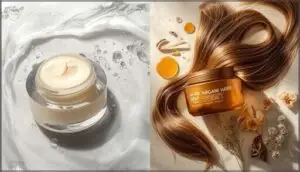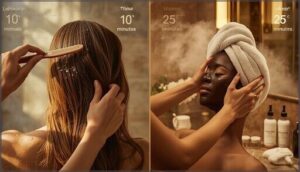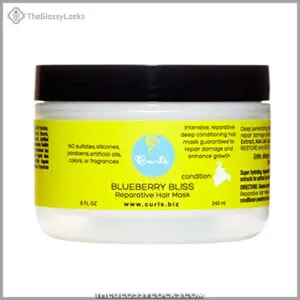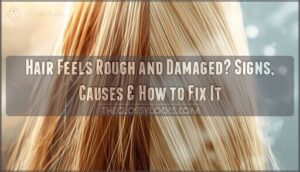This site is supported by our readers. We may earn a commission, at no cost to you, if you purchase through links.

You’ve probably stood in the hair care aisle, staring at bottles labeled “deep conditioner” and “hair mask,” wondering if they’re actually different or just clever marketing. The confusion is real—brands often use these terms interchangeably, yet your hair reacts differently depending on which one you choose.
Deep conditioners work on your hair’s surface to maintain softness and manageability, while hair masks penetrate deeper into the strand to repair structural damage from heat styling, color treatments, and chemical processing.
Understanding the hair mask vs deep conditioner debate isn’t about picking a winner—it’s about matching the right treatment to your hair’s current needs, whether that’s weekly moisture maintenance or intensive damage control.
Table Of Contents
- Key Takeaways
- Hair Mask Vs Deep Conditioner: Key Differences
- What is a Deep Conditioner?
- What is a Hair Mask?
- When to Use a Deep Conditioner
- When to Use a Hair Mask
- Comparing Ingredients and Formulation
- Choosing The Right Treatment for Your Hair
- Top Hair Masks and Deep Conditioners Reviewed
- Frequently Asked Questions (FAQs)
- Conclusion
Key Takeaways
- Deep conditioners maintain your hair’s surface moisture and manageability with weekly use, while hair masks penetrate deeper into the strand to repair structural damage from heat styling and chemical treatments.
- You’ll use deep conditioners 1-2 times weekly for routine hydration that lasts a few days, but hair masks work best for intensive repair 1-3 times weekly depending on your damage level.
- Hair masks contain concentrated proteins like keratin and heavier oils that rebuild your hair’s cortex, whereas deep conditioners use lighter oils and humectants that smooth the cuticle for immediate softness.
- Your hair type determines which treatment works best—fine hair needs lightweight deep conditioners to avoid buildup, while chemically treated or coarse hair requires protein-rich masks for lasting strength and elasticity.
Hair Mask Vs Deep Conditioner: Key Differences
If you’ve ever stood in the hair care aisle wondering whether to grab a hair mask or deep conditioner, you’re not alone. While these products might seem interchangeable at first glance, they actually serve different purposes in your hair care routine.
Let’s break down what sets them apart so you can choose the right treatment for your hair’s needs.
Purpose and Benefits
Understanding hair treatment benefits starts with knowing what each product delivers. Deep conditioners focus on moisture maintenance, restoring hydration levels and softness to your hair’s surface. Hair masks dive deeper, targeting damage repair from heat styling and chemical treatments while improving texture and scalp health. Hair masks also provide extra nourishment to your hair.
| Feature | Deep Conditioner | Hair Mask |
|---|---|---|
| Primary Purpose | Moisture maintenance and softness | Intensive damage repair and restoration |
| Hydration Levels | Surface-level hydration | Deep penetration into hair shaft |
| Usage Intensity | Regular, weekly maintenance | Occasional intensive treatment |
| Key Benefits | Manageability, shine, frizz reduction | Elasticity, strength, texture improvement |
Benefits of hair masks include long-lasting hydration and strengthened hair follicles, while deep conditioner benefits shine through consistent moisture balance. Your hair’s condition determines which treatment delivers the results you need.
Application Methods
How you apply these treatments matters just as much as which one you choose. Deep conditioners go on damp, freshly shampooed hair for 5–15 minutes, coating the surface evenly with your fingers or a wide-tooth comb. Hair masks require a longer application duration—10–30 minutes—and benefit from heat application using a shower cap or warm towel to boost absorption deep into your hair shaft. Consistent use of either can lead to more manageable hair.
| Treatment Type | Pre-Application Prep | Product Distribution | Application Duration |
|---|---|---|---|
| Deep Conditioner | Clean, damp hair after shampooing | Light, even coating with fingers or comb | 5-15 minutes |
| Hair Mask | Clean, detangled damp hair | Thick layer, massaged into mid-lengths and ends | 10-30 minutes (or overnight) |
| Deep Conditioner | Focus on roots to tips (avoid scalp) | Uniform surface coverage | Room temperature |
| Hair Mask | Concentrate on damaged ends | Deep penetration with heat tools or cap | Heat-enhanced for better results |
For scalp application, most deep conditioners should stay away from roots to prevent greasiness, while some hair masks specifically target scalp nourishment. Both treatments work best when you detangle first and distribute product thoroughly before the waiting period begins.
Frequency of Use
Once you’ve nailed your application methods, frequency of use becomes the next piece of the puzzle. Deep conditioners fit easily into your weekly routine—once or twice a week keeps most hair types hydrated without buildup. Hair masks deliver more intensive treatment, so you’ll use them less often: once weekly for normal hair, or 2–3 times weekly if you’re dealing with serious damage from color treatments or heat styling. Seasonal changes and product buildup also influence how often you reach for each treatment.
| Hair Type | Deep Conditioner Frequency | Hair Mask Frequency |
|---|---|---|
| Fine or oily hair | Once weekly | Every 1-2 weeks |
| Normal hair | 1-2 times weekly | Once weekly |
| Dry or damaged hair | 2-3 times weekly | 2-3 times weekly |
| Curly or coily hair | Once weekly | Once weekly |
| Chemically treated hair | 2 times weekly | 2-3 times weekly |
Penetration and Results
Knowing how often you need each treatment matters less if you don’t understand what’s happening beneath the surface. Deep conditioners work on the cuticle—your hair’s outer layer—delivering immediate softness and shine that lasts a few days. Hair masks penetrate the cortex, targeting long-term strength and moisture retention. That cortex repair reduces breakage over time, while cuticle penetration gives you quick manageability.
Deep conditioners smooth your hair’s surface for instant shine, while masks rebuild its core for lasting strength
| Treatment | Where It Works | What You Notice |
|---|---|---|
| Deep Conditioner | Cuticle (outer layer) | Immediate softness, shine, frizz control |
| Hair Mask | Cortex (inner layer) | Long-term strength, reduced breakage, lasting hydration |
What is a Deep Conditioner?
If you’ve ever wondered what sets a deep conditioner apart from your everyday rinse-out product, you’re not alone.
Deep conditioners are formulated to deliver more moisture and nourishment than standard conditioners, helping you maintain soft, manageable hair between treatments.
Let’s break down what makes deep conditioners work, what’s inside them, and how they support your hair’s overall health.
Definition and Function
A deep conditioner is your go-to treatment when you need to restore moisture balance and improve elasticity in dry, brittle hair. It works by penetrating the hair shaft to hydrate from within, while smoothing the cuticle for added shine and manageability.
Unlike hair masks that target intensive repair, deep conditioners maintain softness between washes, making them ideal for regular use.
Common Ingredients
You’ll find most deep conditioners pack a lineup of silk and soy proteins that smooth your cuticle, plus lightweight oils like jojoba and argan to nourish without weighing hair down.
Humectants such as glycerin and aloe vera pull moisture into each strand, while panthenol and vitamin E work together to boost elasticity and shield against damage.
These key ingredients deliver softer, shinier hair with every use.
Benefits for Hair Health
When you work a deep conditioner into your routine, you’re setting yourself up for measurable hair health improvements that go beyond surface-level shine.
- Hydration improvement restores moisture balance and reduces dryness from heat styling and chemical treatments
- Breakage reduction strengthens strands by up to 30%, helping you retain length and thickness
- Damage restoration rebuilds weakened bonds in chemically treated hair through targeted protein delivery
- Hair strength increases by 15-20% with consistent weekly deep conditioner use, protecting against environmental stressors
This hair treatment transforms your hair care game by maintaining scalp vitality and preventing the kind of damage that would otherwise require an intensive hair mask.
What is a Hair Mask?
A hair mask is a more intensive treatment than your regular conditioner, designed to repair and restore hair that’s been through the wringer. Think of it as a rescue mission for damaged, dry, or chemically treated hair that needs serious help.
Let’s look at what goes into these powerhouse products and how they work their magic on stressed-out strands.
Typical Ingredients
Hair masks pack a heavier punch than deep conditioners regarding ingredients. You’ll find concentrated protein types like keratin and collagen that penetrate deep into your hair shaft.
Expect rich oil blends—think argan and shea butter—alongside humectant action from hyaluronic acid and glycerin.
The formulation texture is thicker, too, with vitamin infusion including biotin to strengthen every strand from within.
Intensive Repair Benefits
Intensive repair masks work on a cellular level your regular deep conditioner can’t reach. They rebuild damaged hair by filling protein gaps and reversing chemical stress:
- Damage Reversal: Specialized peptides repair bleaching and heat damage within minutes
- Protein Integration: Keratin restores elasticity and mechanical strength in weakened strands
- Breakage Reduction: 82% of users notice less hair breakage after consistent use
- Cuticle Smoothing: Deep penetration restores shine in over 90% of treated hair
When to Use a Deep Conditioner
Deep conditioners work best when your hair needs consistent care rather than emergency rescue. They’re your go-to for keeping your strands in good shape between more intensive treatments.
Let’s look at the specific situations where reaching for a deep conditioner makes the most sense.
For Moisture Boost
When your hair feels dry and thirsty, reach for a deep conditioner. It provides a quick moisture boost by coating the hair cuticle with lighter oils and humectants, restoring hydration without weighing strands down.
Deep conditioner works well for regular moisturisation needs, especially when ingredient concentration balances softness with manageability. You’ll see immediate results—smoother texture and better hydration—making it perfect for weekly treatment routines.
Maintaining Softness and Shine
Beyond just adding moisture, your deep conditioner excels at maintaining softness and hair shine through regular cuticle smoothing. This hydration impact flattens the hair surface, reducing combing force by up to 85% while enhancing shine longevity.
The differences between deep conditioner and hair mask matter here—routine integration with lighter formulas prevents buildup while ingredient efficacy keeps strands glossy and manageable between more intensive hair mask treatments.
Weekly Hair Care Routines
Most people who care for their hair three or more times weekly benefit from incorporating a deep conditioner into their hair care routine. Treatment Sequencing matters—applying this hair treatment after shampooing locks in moisture consistently.
This Routine Customization approach, with weekly deep conditioning sessions, prevents Product Overlap while managing Budget Allocation better than frequent hair mask purchases, supporting positive Long-Term Effects on hair health.
When to Use a Hair Mask
Hair masks are your go-to when your hair is crying out for serious help. Think of them as the emergency rescue team for strands that have been through the wringer—whether from heat styling, chemical treatments, or just plain neglect.
Here’s when you should reach for a hair mask instead of your regular deep conditioner.
Deep Hydration Needs
When your hair feels parched and lifeless, hair masks deliver up to 6.5 times more hydration than deep conditioners. For dry or chemically treated hair, you’ll want to use masks two to three times weekly to maintain adequate moisture levels.
The concentrated humectants like glycerin penetrate deeper into your hair’s cortex, improving elasticity and locking in hydration that lasts.
Treating Breakage and Split Ends
Protein-rich hair masks target the root cause of breakage by repairing your hair’s internal structure, not just coating the surface. These concentrated ingredients replenish depleted keratin and seal split ends through multiple wash cycles, delivering measurable outcomes that deep conditioners simply can’t match.
You can reduce breakage by up to 76% with weekly mask application, especially if you’ve chemically treated your hair.
Reviving Damaged or Chemically Treated Hair
When chemical treatments strip your hair’s natural protein bonds, you need more than surface-level hydration. Hair masks deliver targeted protein replenishment directly to your cortex, reversing chemical disruption while supporting scalp health.
Apply twice weekly for three to six months to counteract long-term effects like thinning and brittleness. This treatment frequency ensures damaged hair receives sustained repair that deep conditioner maintenance can’t provide alone.
Comparing Ingredients and Formulation
When you flip over a hair mask or deep conditioner, the ingredient list tells you exactly what kind of work the product can do. The formula determines how deeply it penetrates your hair and where you should apply it for the best results.
Let’s break down the key differences in what’s actually inside these treatments and how they function differently on your hair.
Proteins, Oils, and Emollients
When you’re comparing hair masks and deep conditioners, understanding their ingredients helps you choose the right treatment. Hair masks pack more intensive proteins like keratin and biotin for deep repair, while deep conditioners focus on oils and emollients for surface-level moisture.
- Protein penetration: Hair masks use hydrolyzed proteins that rebuild your hair’s core structure
- Oil benefits: Both products contain argan, coconut, and avocado oils, but masks combine them with proteins for balanced nourishment
- Emollient types: Natural butters like murumuru prevent water loss and boost smoothness
- Ingredient synergy: Masks blend proteins, oils, and humectants together, while deep conditioners emphasize moisture-sealing emollients
Penetration Depth and Hair Shaft Repair
When your hair needs repair, penetration depth makes all the difference. Hair masks reach the cortex for molecular bond reconstruction and protein replenishment methods, targeting internal hair damage. Deep conditioners focus on cuticle layer repair and surface hydration.
Heat application effects improve cortex penetration rates for both treatments, but masks penetrate deeper into the hair shaft, delivering intensive hair repair that conditioners can’t match.
Scalp Vs. Ends Application
Where you apply your treatment matters just as much as which one you choose. Deep conditioners work best from mid-lengths to ends hydration, preventing scalp buildup and product residue on oily scalp types.
Hair masks can target the scalp health when formulated for dryness, but generally focus on damaged ends where the hair shaft needs repair most—especially for split ends and breakage.
Choosing The Right Treatment for Your Hair
Now that you understand how these treatments work, it’s time to figure out which one your hair actually needs. The right choice depends on your specific hair type, any chemical treatments you’ve had, and how often you should be using these products.
Let’s break down the key factors that’ll help you make the best decision for your hair.
Hair Type and Texture Considerations
Your hair type and texture determine which treatment works best. Fine strands absorb products quickly but risk buildup, so stick with lightweight formulas.
Coarse or curly hair with low porosity needs richer masks to combat dryness and frizz.
If you’re dealing with texture damage from heat styling, consider curl patterns and scalp oiliness when choosing between masks and deep conditioners for lasting results.
Color-Treated and Relaxed Hair
When you’ve colored or relaxed your hair, chemical damage is real. Hair masks deliver color vibrancy protection and intense hydration to shield dye molecules from fading.
For relaxed hair, protein-rich deep conditioners improve elasticity and rebuild strength that straightening strips away.
Application techniques matter—use masks post-coloring for cuticle repair, and apply deep conditioners weekly with heat to boost ingredient efficacy and prevent breakage.
Frequency Recommendations
Once you’ve chosen your treatment, timing becomes your next ally. Most hair types thrive on weekly deep conditioning to maintain moisture and prevent buildup.
Damaged or chemically treated hair? You’ll need hair masks 2–3 times weekly for repair. Factor in porosity levels and seasonal changes—high porosity hair loses moisture faster, while winter dryness demands more frequent application regardless of your hair care routine.
Top Hair Masks and Deep Conditioners Reviewed
Now that you know the differences between hair masks and deep conditioners, it’s time to look at some standout products that actually deliver results.
We’ve reviewed a few options that work well for different hair needs, from intensive repair to everyday moisture. Here’s what you should consider adding to your routine.
Blueberry Bliss Reparative Hair Mask
For curl enthusiasts seeking intensive damage repair, the Blueberry Bliss Reparative Hair Mask stands out with its certified organic ingredients like blueberry extract, aloe, and chamomile. This hair product comparison favorite offers real curl definition benefits that customer reviews consistently praise.
You’ll apply it to wet hair after cleansing, leaving it on for 15-25 minutes weekly. Unlike a typical deep conditioner, this hair mask penetrates deeply to repair breakage and split ends, making it essential hair care for damaged or chemically treated curls requiring serious restoration.
Popular Deep Conditioner Options
While masks handle serious damage, regular deep conditioner options keep your hair healthy between treatments. Marc Anthony’s leave-in spray leads sales at over 61,000 monthly units, offering sulfate-free convenience for curly hair. Redken All Soft targets dry strands with protein-rich formulas, while Nexxus Humectress delivers consistent moisture with argan oil.
Regional preferences vary—North America favors professional brands, while Asia Pacific gravitates toward ingredient analysis and natural formulations in their hair care product comparison.
Product Selection Tips
When comparing hair care products, start your ingredient analysis with proteins and oils near the top of the list. Consider your hair porosity—low porosity needs lighter formulas, while high porosity demands richer treatments.
Budget considerations matter, but brand reputation and ethical sourcing shouldn’t be ignored. Check for sulfate-free claims and third-party testing.
Understanding hair mask benefits helps you choose between intensive repair and routine moisture maintenance.
Frequently Asked Questions (FAQs)
Can you use both treatments together simultaneously?
You can layer both treatments for extra nourishment, but timing matters. Apply your hair mask first, rinse thoroughly, then follow with deep conditioner. This maximizes repair and moisture retention effectively.
How much product should you apply each time?
The application amount depends on your hair thickness and length. For medium-length hair, use about 10–15 grams—roughly two to three teaspoons—of hair mask or deep conditioner per treatment.
Do hair masks expire or lose effectiveness over time?
Yes, hair masks do expire. Over time, ingredient degradation and microbial growth reduce effectiveness.
Watch for expiration indicators like odd smells, texture changes, or color shifts—these signal it’s time to toss your product.
Can deep conditioning cause hair to become too soft?
Deep conditioning for too long—beyond 30 minutes—can lead to over-softening risks, weakening hair elasticity and causing breakage.
Maintaining protein balance and adjusting conditioning duration helps prevent hair damage while supporting effective hair repair.
Are there any ingredients to avoid in these treatments?
Watch out for sulfates, parabens, harmful alcohols, and synthetic fragrances in hair mask ingredients and deep conditioner ingredients.
Silicone buildup weighs hair down, while sulfate alternatives offer gentler cleansing without stripping natural oils.
Conclusion
Think of your hair care routine like maintaining a car—regular oil changes keep things running smoothly, but sometimes you need a full engine overhaul.
Deep conditioners handle your weekly upkeep, preserving what’s already working. Hair masks step in when damage demands serious intervention.
The hair mask vs deep conditioner choice isn’t complicated once you assess your hair’s condition honestly. Listen to what your strands are telling you, then treat accordingly.
- https://www.instagram.com/rogeriocavalcante/?hl=en
- https://www.gkhair.com/blogs/all-blog-posts/how-often-should-you-use-a-deep-conditioning-hair-treatment-for-dry-hair
- https://catherineandcosalon.com/blog/hair/benefits-hair-mask/
- https://www.glamour.com/story/what-is-a-hair-mask
- https://www.facebook.com/groups/bebeautifulindia/posts/8182457538497558/














